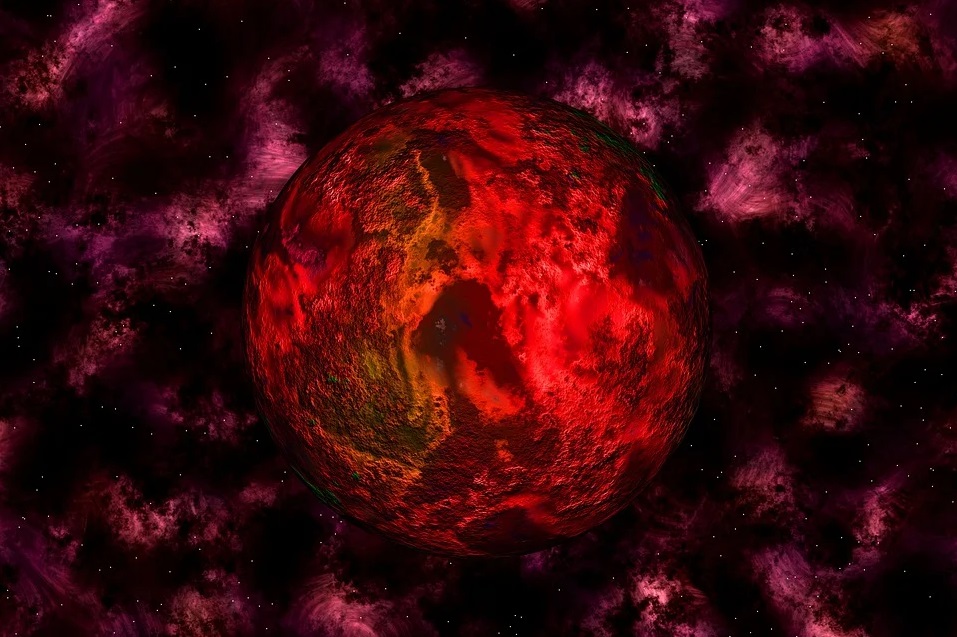This burning planet is located at a distance of 855 light years from Earth Doomed to death by himself star. The search for planets outside our solar system has revealed more than 4,000 distant worlds, but a team of astronomers at the Massachusetts Institute of Technology has discovered one of the strangest and most extreme.
It’s a “super-hot” planet Jupiter, which is five times the mass of our Jovian universe, and orbits its star every 16 hours! Its orbit is the shortest of all the gas giants known to date. Of course, life on the edge is doomed to disaster. On May 13, 2020, NASA’s TESS satellite dedicated to searching for exoplanets began observing TOI-2109, a star located in the southern part of the constellation Hercules, about 855 light-years from Earth. The mission identified the star as an interesting object because of the possibility that it could host a planet orbiting it.
Thanks to transits – periodic drops in starlight that indicate an object is passing in the foreground – observed by TESS and observed by several ground-based telescopes, astronomers have confirmed the existence of a planet called TOI-2109b, whose orbit lasts about 16 hours. “We realized we had something very interesting and relatively rare.”says Avi Shporer of the Kavli Institute for Astrophysics and Space Research at the Massachusetts Institute of Technology.
Always day and night on this planet
The team determined that TOI-2109b is five times larger than Jupiter, 35 percent larger, and very close to its star, at a distance of about 2,400,000 km. It may seem like a lot, but it isn’t at all. By comparison, Mercury is about 70 million km from the Sun.
Given the planet’s dimensions and proximity to its star, the researchers determined that TOI-2109b was an extremely hot Jupiter, with the shortest orbit of any known gas giant. Like most hot Jupiters, the planet appears to be locked in tides, and has a perpetual day and night aspect, similar to the Moon relative to the Earth.
Through the TESS observations, the researchers were able to watch the changing brightness of the planet as it rotates on its axis. By observing the passage behind their star (known as the secondary ecliptic) at both optical and infrared wavelengths, they estimated that the diurnal side reaches temperatures of more than 3,200 degrees Celsius. It’s almost as hot as a little star. This makes the TOI-2109b The second most important planet discovered so far.
“In the meantime, the brightness of the night side of the planet is less than sensitive to the TESS data, which raises questions about what’s really going on there,” says Sporer. “Is the temperature there too cold, or does the planet somehow take the heat from the day and transfer it to the night side? We’re just beginning to try to answer that question for these super-hot buyers.”, Add.
pilgrim caries
But this planet will not last long. It’s heading toward its star, 50% larger and more massive than our sun, at a rate of 10 to 750 milliseconds per year, faster than any hot Jupiter observed to date. This is called an “orbital disintegration” process, like the water in the shower going around the drain.
The discovery offers a unique opportunity for astronomers to study how planets behave when they are attracted to and swallowed up by their star. “In a year or two, if we’re lucky, we might be able to figure out how the planet approaches its star”says Ian Wong, lead author of the discovery, a postdoctoral researcher at the Massachusetts Institute of Technology while studying and now at NASA’s Goddard Space Flight Center. “We will never in our lifetime see the planet fall into its star. But give it another 10 million years and this planet may not exist.”, Concludes.
TOI-2109b
Researchers hope to observe TOI-2109b with more powerful instruments in the near future, including the Hubble Space Telescope and the James Webb Space Telescope, which will be launched soon. “Superhot Jupiters like TOI-2109b are the most extreme subclass of exoplanets”Wong says. “We are just beginning to understand some of the unique physical and chemical processes that occur in the atmosphere, processes that have no analogues in our solar system.”.
Future observations of TOI-2109b may also reveal clues to how these amazing systems came to be in the first place. “Since the beginning of exoplanet science, hot Jupiters have been viewed as eccentric”Little Shapur. How can a huge planet as big as Jupiter reach an orbit that only lasts a few days? We don’t have anything like it in our solar system, and we see this as an opportunity to study them and help explain their existence.”He adds.
The search was published in “Astronomical Journal”.
Source: J. de Jorge / ABC,
Reference article: https://www.abc.es/ciencia/abci-descubren-extrano-planeta-cuyo-dura-16-horas-202112011330_noticia.html#ancla_comentarios,

“Beer enthusiast. Subtly charming alcohol junkie. Wannabe internet buff. Typical pop culture lover.”







More Stories
Pre-registration for Zenless Zone Zero is now open globally on all platforms
Nothing can be said for the Phone 3 in July
iPhone 15 price drops like never before on Amazon